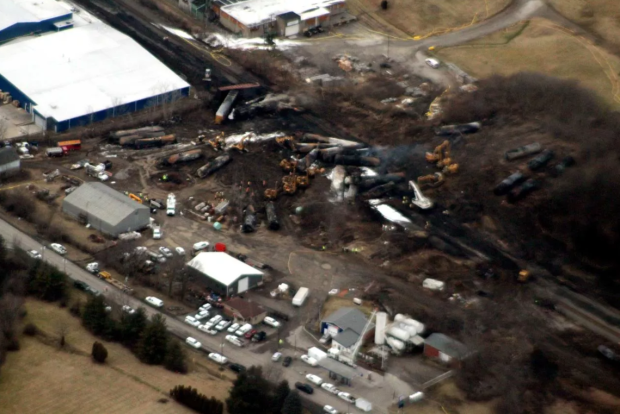Months-Long Persistence Of Toxic Chemicals After Ohio Train Derailment

Table of Contents
The Initial Impact and Immediate Response
On February 3, 2023, a Norfolk Southern freight train carrying hazardous materials derailed in East Palestine, Ohio. The immediate aftermath involved a controlled burn of vinyl chloride, a highly volatile and carcinogenic chemical, to prevent a potential explosion. This decision, while arguably necessary to mitigate immediate risks, released potentially harmful byproducts into the air. The incident led to the evacuation of thousands of residents and sparked widespread concerns about the immediate and long-term consequences.
- Chemicals Released: The train was carrying a cocktail of toxic chemicals, including vinyl chloride (a known carcinogen), butyl acrylate (an irritant and potential respiratory hazard), and ethylene glycol monobutyl ether (potentially harmful to the reproductive system).
- Initial Response: The initial response involved evacuations, the controlled burn of vinyl chloride, and initial air and water quality testing. However, the scope and effectiveness of these initial measures remain subjects of ongoing debate.
- Initial Assessments: Early assessments focused on immediate threats, but the extent of the environmental damage was not fully understood initially. The long-term effects on soil, water, and the surrounding ecosystem were largely unknown at that time.
Evidence of Months-Long Persistence of Toxic Chemicals
Months after the derailment, evidence continues to mount demonstrating the persistent presence of toxic chemicals in East Palestine and the surrounding areas. This isn't just about immediate contamination; it's about the lingering effects of these hazardous substances.
- Soil and Water Contamination: Tests have revealed elevated levels of contaminants in soil and water samples, indicating significant environmental contamination that extends beyond the immediate vicinity of the derailment.
- Air Quality Monitoring: Air quality monitoring data, though sometimes inconsistent, shows lingering pollutants long after the initial controlled burn. This raises concerns about long-term exposure risks for residents and wildlife.
- Contamination in Wildlife and Livestock: Reports of dead animals and sick livestock further highlight the pervasive nature of the contamination. Studies are ongoing to determine the full extent of this impact on the local ecosystem.
Long-Term Health Concerns and Environmental Impacts
The long-term consequences of exposure to these toxic chemicals are deeply concerning. The potential for significant health problems among residents and lasting environmental damage is undeniable.
- Potential Long-Term Health Effects: Exposure to vinyl chloride, butyl acrylate, and other released chemicals can lead to a range of serious health problems, including respiratory illnesses, cancers, neurological disorders, and reproductive issues. Long-term studies will be crucial to fully understand the extent of these health impacts.
- Environmental Damage: The contamination of soil and water sources poses a serious threat to the local ecosystem. The effects on wildlife, agriculture, and water quality are likely to be far-reaching and long-lasting.
- Observed Health Problems: Reports of headaches, nausea, and respiratory problems among residents near the derailment site are raising serious concerns about potential long-term health issues. Further epidemiological studies are needed to establish direct links between chemical exposure and observed health problems.
Ongoing Investigations and Remediation Efforts
Government agencies, along with independent researchers, are conducting ongoing investigations to determine the full extent of the contamination and the effectiveness of remediation efforts. However, gaps in information and transparency remain a significant concern.
- Ongoing Lawsuits: Several lawsuits have been filed against Norfolk Southern and other involved parties, seeking accountability for the environmental damage and health impacts resulting from the derailment.
- Remediation Strategies: Current remediation strategies involve soil removal, water treatment, and ongoing air quality monitoring. However, the long-term success of these efforts remains to be seen.
- Gaps in Investigation and Remediation: Questions remain about the thoroughness of the initial response, the accuracy of the ongoing monitoring, and the long-term effectiveness of the remediation strategies. Increased transparency and independent oversight are essential.
The Role of Regulation and Prevention
The Ohio train derailment underscores the urgent need for stricter regulations and preventative measures to prevent similar incidents in the future. This requires a comprehensive reassessment of railway safety, hazardous materials transportation, and emergency response protocols.
- Railway Safety Regulations: Improvements to track maintenance, inspection procedures, and the safety standards for transporting hazardous materials are critical.
- Emergency Response Protocols: Clearer, more effective emergency response protocols are needed to ensure swift and efficient responses to derailments involving hazardous materials.
- Regulations on Hazardous Materials: Stricter regulations on the transportation of hazardous materials, including improved packaging, stricter transportation routes, and enhanced tracking systems, are essential to reduce the risk of future incidents.
Conclusion
The months-long persistence of toxic chemicals following the Ohio train derailment presents a grave and ongoing environmental and public health crisis. The evidence clearly indicates significant environmental contamination and raises serious concerns about the long-term health consequences for residents. The need for continued monitoring, thorough investigation, comprehensive remediation, and significant regulatory reform cannot be overstated. We must demand accountability from responsible parties, support affected communities, and advocate for stronger environmental regulations to prevent future incidents of this nature. Contact your representatives and demand action to prevent future catastrophes stemming from the months-long persistence of toxic chemicals in similar situations.

Featured Posts
-
 Analyzing The Most Stylish Oscars Afterparty Attire
May 06, 2025
Analyzing The Most Stylish Oscars Afterparty Attire
May 06, 2025 -
 Diana Ross 1973 Royal Albert Hall Concert A Night To Remember
May 06, 2025
Diana Ross 1973 Royal Albert Hall Concert A Night To Remember
May 06, 2025 -
 Obraschenie Religioznykh Liderov Azerbaydzhana K Premer Ministru Velikobritanii Tekst I Analiz
May 06, 2025
Obraschenie Religioznykh Liderov Azerbaydzhana K Premer Ministru Velikobritanii Tekst I Analiz
May 06, 2025 -
 Office365 Security Breach Leads To Millions In Losses For Executives
May 06, 2025
Office365 Security Breach Leads To Millions In Losses For Executives
May 06, 2025 -
 Fortnite Sabrina Carpenter Skin How To Obtain And When To Look
May 06, 2025
Fortnite Sabrina Carpenter Skin How To Obtain And When To Look
May 06, 2025
